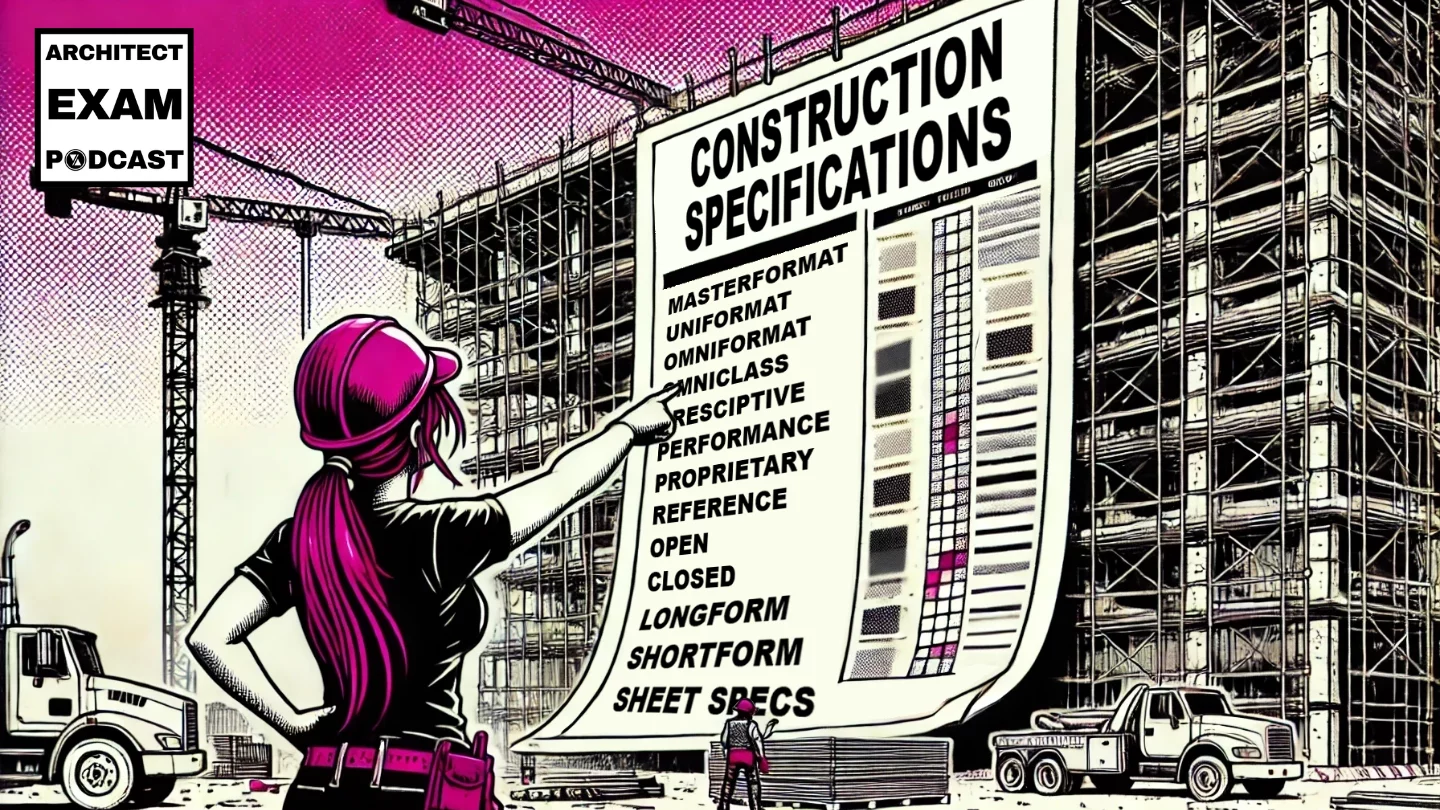This guide demystifies all major construction specification types and helps you understand when and how to use each one. These distinctions will make you more effective at writing, interpreting, enforcing, and managing construction documents.
This podcast is also available on YouTube, Spotify, and Apple Podcasts
The Backbone of Construction Documents
Construction specifications are the unsung heroes of the building industry. While drawings show what a building looks like, specifications tell contractors how to build it, what materials to use, and to what standards the work must be performed. These written documents form a critical component of your contract documents and serve as the rulebook that guides construction from start to finish.
If you’re preparing for the Architect Registration Exam (ARE) or the Construction Documents Technologist (CDT®) certification, understanding construction specification types is non-negotiable. Both exams test your knowledge of these crucial documents, and your ability to read, write, and navigate specifications will directly impact your projects’ success.
This guide will walk you through the major construction specification types, their applications, and when to use each one. Let’s dive into the world of specifications, demystifying this essential yet often intimidating component of construction documentation.
Part 1: Specification Classification Systems
Before we explore individual construction specification types, it’s important to understand the major classification systems that organize construction information.
MasterFormat®
MasterFormat® is perhaps the most recognizable classification system in North America. Developed by the Construction Specifications Institute (CSI), it organizes construction information by work results and activities into numbered divisions.
What It Is: MasterFormat breaks construction into 50 divisions, each assigned a specific number and scope. For example:
- Division 03: Concrete
- Division 06: Wood, Plastics, and Composites
- Division 09: Finishes
- Division 26: Electrical
MasterFormat is the standard for organizing detailed construction specifications, used in the construction phase when individual trades need clear instructions on their specific scope of work. Its key benefit is creating a common language across the industry – when an electrician needs to find requirements for their work, they know to look in Division 26.
UniFormat®
While MasterFormat organizes by who does the work, UniFormat® takes a different approach.
What It Is: UniFormat classifies by building elements or systems, focusing on what the building consists of rather than who builds it. It’s organized into major categories like:
- A: Substructure
- B: Shell (including B20: Exterior Enclosure)
- C: Interiors
- D: Services (including D30: HVAC)
UniFormat shines in early project stages, especially for preliminary specifications, cost estimating, conceptual design, and building systems analysis. By organizing information around building systems rather than trades, it provides a big-picture view during early design phases.
OmniClass®
OmniClass® represents the most comprehensive classification system in construction.
What It Is: OmniClass incorporates both MasterFormat and UniFormat, plus additional classifications. It’s designed to catalog all construction information for the entire building lifecycle.
OmniClass is particularly valuable for Building Information Modeling (BIM) projects, facility management, detailed asset tracking, and complex projects needing multiple classification perspectives. Its comprehensive nature makes it ideal for digital building management throughout a building’s life. When implemented properly, these classification systems help architects establish effective quality assurance procedures during the documentation phase.
Part 2: Specification Writing Approaches
Beyond how specifications are classified, there are significant differences in how they’re written.
Prescriptive vs. Performance Specifications
Prescriptive Specifications
What It Is: A prescriptive specification details materials, products, and execution methods with little room for deviation. It’s like a recipe that specifies both ingredients and cooking method.
When To Use It:
- Traditional design-bid-build projects
- When you need tight control over construction methods
- When proven, specific solutions are required
- When contractors may lack specialized design expertise
Example: A prescriptive concrete specification would specify exact strength (4000 PSI), specific mix design, reinforcement specifications, curing method, and joint spacing.
Limitation: If a contractor follows your prescriptive specification exactly and the result fails, they may point to your specifications as the source of the problem.
Performance Specifications
What It Is: Performance specifications describe what the finished product must do or achieve, without dictating how to get there.
When To Use It:
- Design-build projects
- When innovation is encouraged
- When contractors have specialized expertise
- When multiple technical solutions could achieve the same goal
Example: A performance window specification might state: “Windows shall have a maximum U-factor of 0.30” and “Must resist water penetration at 15 psf.”
Challenge: You must anticipate all important performance aspects, or you might get technically compliant results that still don’t meet your real needs.
Proprietary Specifications
What It Is: Proprietary specifications call for specific products from specific manufacturers.
When To Use It:
- When a specific product is required for performance or aesthetic reasons
- When matching existing materials in renovations
- When an owner has strong brand preferences
- For specialty systems with limited options
Example: “Pendant Light: LightingCo Model ABC in Matte Black finish with dimmable LED kit by LEDCorp.”
Drawback: Proprietary specifications limit competition, potentially increasing costs. There’s also the risk that specified products might become unavailable during construction.
Reference Specifications
What It Is: Reference specifications incorporate standards, codes, or other documents by referring to them rather than writing out all the requirements.
When To Use It:
- Nearly all projects use reference specifications to some degree
- When industry standards already cover requirements thoroughly
- To avoid lengthy restatements of standard practices
Example: “Install single-ply membrane roofing in accordance with NRCA Roofing Manual and manufacturer’s written instructions.”
Challenge: Everyone involved needs access to the referenced documents, and you must specify which edition applies to avoid confusion.
Part 3: Product Selection Flexibility
Another important dimension of specifications is how much flexibility they provide in product selection.
Open Specifications
What It Is: Open specifications allow multiple products or manufacturers as long as they meet certain standards. They typically include phrases like “or equal” or list several acceptable manufacturers.
When To Use It:
- Public projects where competition is required
- When multiple products could satisfy requirements
- When budget is a priority
- When material availability might be uncertain
Example: “Concrete Masonry Units meeting ASTM C90, Medium Weight. Manufacturers include: ACME Blocks, BuildStone Co., or approved equal.”
Open specifications promote competitive pricing and give contractors flexibility if specified products become unavailable. They also encourage innovation by allowing contractors to propose solutions you might not have considered.
Closed Specifications
What It Is: Closed specifications name specific products or manufacturers with no substitutions allowed.
When To Use It:
- When matching existing materials in renovations
- For specific aesthetic requirements where no substitute would be acceptable
- When an owner has standardized on certain products
Example: “Stone cladding shall be Mountain Creek Quarry, Colonial Cut, Lot #5372 only. No substitutions.”
The primary disadvantage is higher cost due to lack of competition. Additionally, if specified products become unavailable, project delays may result.
Part 4: Specification Document Length and Format
The final major distinction involves how specifications are formatted and their level of detail.
Long-Form Specifications
What It Is: Long-form specifications are comprehensive documents organized by CSI MasterFormat sections. Each section follows the standard three-part format: General, Products, and Execution.
When To Use It:
- Medium to large commercial projects
- Projects with complex requirements
- Public or institutional buildings
- Projects with formal bidding processes
Long-form specifications provide clear delineation of responsibilities and stronger legal protection.
Short-Form Specifications
What It Is: Short-form specifications are abbreviated versions covering essentials without the depth of long-form specs.
When To Use It:
- Smaller projects
- Residential work
- Projects with straightforward requirements
- When working with contractors unfamiliar with formal specifications
Example: For a small library renovation, a short-form specification might simply list the paint type for walls, carpet specifications, and basic installation notes.
Sheet Specifications
What It Is: Sheet specifications place specification information directly on drawing sheets rather than in a separate book.
When To Use It:
- Small-scale projects with limited scope
- Simple renovations
- Projects with few trades involved
- When working with familiar contractors
Limitation: Sheet specifications don’t have enough space for complex projects or detailed requirements.
Part 5: Practical Applications and Exam Considerations
Choosing the Right Construction Specification Type
In practice, specification choices depend on numerous factors:
- Project Size: Larger projects generally require more formal, detailed specifications
- Delivery Method: Design-build projects often use performance specs, while design-bid-build often uses prescriptive
- Public vs. Private: Public projects typically require open specifications to ensure fair competition
- Budget Constraints: Open specifications generally promote cost savings through competition and better contingency funds planning
- Design Control: Prescriptive and closed specifications provide maximum control but less flexibility
- Innovation Needs: Performance and open specifications encourage creative solutions
Most projects use a strategic combination of construction specification types. You might use performance specs for complex mechanical systems where contractor expertise is valuable, but prescriptive specs for architectural finishes where appearance is critical.
Specifications on the ARE and CDT® Exams
Both the Architect Registration Exam and the Construction Documents Technologist certification test your understanding of specifications:
- ARE Exam Focus: The Project Planning & Design (PPD), Project Development & Documentation (PDD), Construction & Evaluation (CE), and Project Management (PjM) divisions particularly test specification knowledge, including coordination, bidding requirements, and specification types.
- CDT® Certification: The CDT® exam thoroughly tests your understanding of construction specifications, including CSI formats, specification types, and how specifications interact with other contract documents.
Study tips for specification questions:
- Understand the distinction between prescriptive and performance specifications
- Know when open versus closed specifications are appropriate
- Be familiar with the three-part format of specifications
- Understand how specifications coordinate with drawings
Need more targeted practice on these specification concepts? Our CDT 101 course thoroughly breaks down everything listed in this guide with practical examples and expert instruction. For ARE candidates, we’ve written many practice questions related to the different specification types for each exam division in our ARE 101 course series. These practice questions help you apply the concepts in the exam context you’ll face.
Mastering Specification Types: Your Path Forward
Construction specifications might seem intimidating at first, but understanding their types and applications transforms them into powerful tools for successful building projects. By choosing the right construction specification type for each situation, you ensure clarity, appropriate quality, and avoid costly misunderstandings.
Whether you’re writing sheet specifications for a small renovation or preparing long-form specs for a major commercial project, the fundamentals remain the same: clarity, completeness, and coordination with drawings are essential.
Great projects start with great specs. By mastering the various construction specification types, you’re well on your way to becoming a more effective design professional—and passing those exams.
Looking for more resources to help with your ARE or CDT exam preparation? Visit Young Architect Academy for comprehensive resources designed to help you master construction documentation concepts and pass your exams with confidence.



